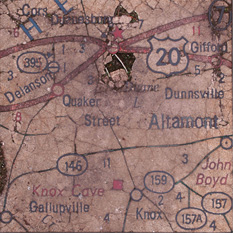
Terrazzo is a composite material poured in place or precast, which is used predominately for floors and other surface treatments. It consists of chips of marble, quartz, granite, glass or other aggregate with a cement or epoxy binder and often pigments for additional color. Terrazzo is cured, ground and usually polished to a smooth surface to produce a durable and artistic surface. Terrazzo has a long and rich history that dates back to over 1500 years. It is derived from the Roman technique of opus signinum, a simple type of mosaic pavement based on a mortar of lime, volcanic sand (pozzolana) or brick dust, and crushed marble, and inserted with isolated mosaic tesserae. The technique was later revived by the Venetians in the late fifteenth century as Pavimento alla Veneziana or later Palladiana, named after the famous Venetian architect Palladio who frequently used the material in his villas. Small random pieces of of white or colored marble waste chips from slab marble processing ranging between ½ - 2 inches were mixed with mortar and poured, ground and polished to create a durable, light-weight floor.
Terrazzo was introduced to the United States in the late nineteenth century although earlier isolated examples exist from the eighteenth century such as at Mount Vernon. Terrazzo flooring along with mosaic pavements became popular by the 1920s with the introduction of improved technical processes including electric polishing and the use of new materials such as Portland cement and brass or zinc divider strips to control cracking and outline decorative designs. Immigration from Italy brought many skilled artisans to the United States during this period, among them terrazzo and mosaic craftworkers
The functional and decorative possibilities of terrazzo made it the material of choice for many public buildings including shops, restaurants, hotels, and government offices. Today terrazzo remains a highly versatile and durable material for floors, walls and even individual works of art. There are three types of installation methods for terrazzo: monolithic, bonded, and sand cushioned (or unbonded). Unbonded terrazzo was the type was used at the New York State Pavilion.
